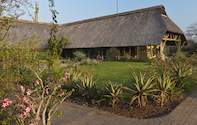
At the last stock take in March, the Skukuza Nursery had 1.2 million plants - give or take a few seedlings. Now under the steady hand of Ona Davies, the nursery was initially taken over in 1975 by Harry Matthysen, who began its commercialisation along with his wife Patty. When Harry was appointed as horticulturalist, he inherited a nursery a fraction of its current size, with just over 3,000 plants and a single hosepipe with 28 leaking joins. Of the plants, staff members claimed ownership of two-thirds of them, and a senior staff member was siphoning water away from the nursery's water source for his own garden.
Renowned today as a source of indigenous plants, the nursery sells to members of the public, other nurseries and to landscaping companies. It was initially started to provide plants for the camp gardens throughout the park, Harry's main responsibility. The nursery was opened to the public in 1977, but the responsibility for the camp gardens has been contracted out for almost a decade. There are between 200 and 220 plant species for sale in the nursery, mostly trees and shrubs, but also a variety of groundcovers, bulbs and other types of plants.

The only species sold that is not indigenous to South Africa is the Australian tree fern. Ona says, "There is a big demand for ferns. We had previously bought indigenous ferns, but it was too hot for them here and we lost many plants."
The nursery had to obtain special dispensation to sell the Australian plant, and was only allowed to do so because it does not spread. A perennial favourite among customers is the impala lily, selling for a mere R1.50 in the 70s. Currently, the most expensive plant in the nursery is a baobab tree, this year's tree of the year, which stands well over 3 metres high and costs R600.
Harry motivated for the nursery to be moved to bigger and more appropriate grounds with the decision to sell plants to the public. A jackalberry stump in the nursery marks the location where a pride of lions was lying when Harry, the surveyor, and his assistants ventured out on foot to stake out the new boundaries. When the lions started roaring, Harry recollects that the race back to the van was swift, and that the assistants lay flatter than rubberising in the back of the van when they got there.

Today the nursery is still diversifying. A Working for Water display teaches groups of school children about the hazards of alien plants, but Ona and Working for Water are hoping to add an interpretive trail to the educational experience. Using the existing watercourse next to the nursery, a wetlands walk could be created. This would add to the nursery's educational value. Already school groups learn about how the plants in the nursery are grown and nurtured, including inputs such as water and compost.
The nursery makes its own compost using leaves collected in the Skukuza camp. The wetlands walk interpretive trail could highlight the importance of wetlands, and at the same time provide a seed store for the nursery. Other the seeds for the plants sold in the nursery are collected within Kruger. With 15 years of experience, Ona knows all the good places to find seeds.
She collects seeds throughout the year as the different species shed their reproductive material, and regularly collects amongst the resident's houses in the Skukuza staff village. The nursery is open seven days a week, closing for lunch every day. Over the weekends it is staffed by honorary rangers from the lowveld region, who have performed this service since 1992.

 The Sabie River bush between Skukuza and Lower Sabie has one of the highest concentrations of leopard in the world....
The Sabie River bush between Skukuza and Lower Sabie has one of the highest concentrations of leopard in the world....